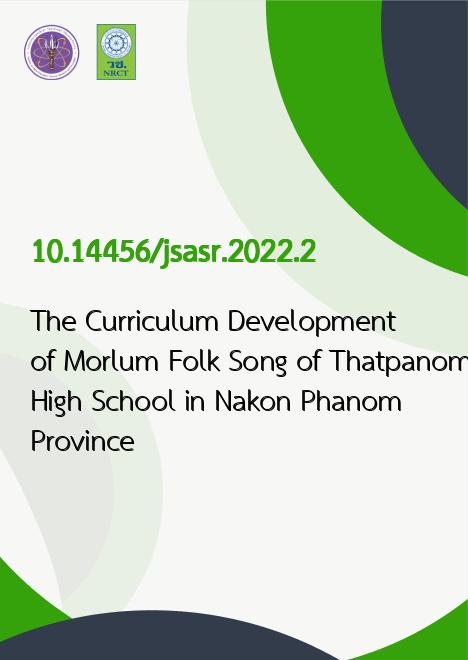
|
The Curriculum Development of Morlum Folk Song of Thatpanom High School in Nakon Phanom Province |
|---|---|
| รหัสดีโอไอ | |
| Creator | Rinda Prakobboon |
| Title | The Curriculum Development of Morlum Folk Song of Thatpanom High School in Nakon Phanom Province |
| Publisher | DR.KEN Institute of Academic Development and Promotion. |
| Publication Year | 2565 |
| Journal Title | International Journal of Sociologies and Anthropologies Science Reviews (IJSASR) |
| Journal Vol. | 2 |
| Journal No. | 1 |
| Page no. | 13_22 |
| Keyword | Curriculum Development, Morlum Folk Song |
| URL Website | https://so07.tci-thaijo.org/index.php/IJSASR/issue/view/82 |
| Website title | https://so07.tci-thaijo.org/index.php/IJSASR/article/view/407 |
| ISSN | 2774-0366 |
| Abstract | The objective of this research was to study Thai folk songs or dramas and factors as well as aesthetics in northeastern Thailand to make learning plans to develop and evaluate the curriculum of the Morlum folk songs as well as to build temporary innovations in the school. The research is a qualitative study through the documents and the interviews of 40 informants: 10 experts, specialists, authors and singers, 10 curricular experts, and 20 artists of singers from the Morlum Folk Song Association. The 6 learning plans were tested with 97 students of 3rd level secondary classrooms 3/1, 3/2, 3/9 of That Phanom High School in Nakhon Phanom Province. The study found that the Morlum learning system was an oral system called Mukhapatha, starting with the word "Oh-La-Nor" to adjust the voice to the sound of a musical instrument, a reed mouth organ, called "Caen" together with proper physical postures and dances as guided and taught by the instructors. Having finished and completed their courses of trains and practices, the students perform the ceremony of paying homage to the instructors by presenting them something such as flowers and other valuable things. The types of Morlum folk songs are classified according to the styles of rhythm as follows: 1) Short style called Lum Thang Sun, 2) Long style called Lum Thang Yao or Lum Long, 3) Lum Teoy styles such as Teoy Khong and Teoy Phama, and 4) Lum Phleon style with different funny manners. As for aesthetics, various emotional expressions are available in the Morlum folk songs as follows: Rati (Love), Hassa (Happiness), Krodha (Anger), Usaha (Bravery), Bhaya (Fear), Yugupsa (Hate), Vismaya (Confusion), and Soka (Grief). The curricular development of Morlum folk songs in educational institutions is regarded as the conversation of the cultural heritage of the nation. Because the Morlum folk songs reflect arts, culture, economy, society, traditions as well as ways of life of the people in the society. The interested people can use the internet to develop the Morlum learning system such as teaching online to improve and conserve the Morlum folk songs as cultural heritage of the nation forever. |
